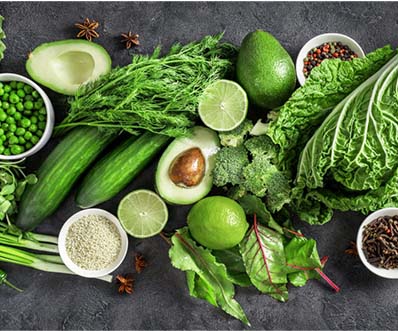SUBJ: Easy – spinach and colorful fruits and veggies
SUBtitle: Linus Pauling Symposium notes
SHORT NOTES: Dietary spinach reshapes the gut microbiome; For a longer life, eat Colorful vegetables and fruits, berries, olive oil, fish, beans; From a 3 hour microbiome symposium: 1) Xanthohumol (from beer hops) is likely to prevent metabolic syndrome; Those consuming more types of plants benefit from a greater microbiome diversity; different fibers in 5 different groups of fruits and veggies e.g. walnuts vs almonds vs. broccoli vs avocadoes vs oats each enriched different beneficial bacteria in the gut; bidirectional communication between gut and the brain alter brain and mood and cognition; clinical trial 29 yr olds, much better memory after regular kefir consumption; eating prebiotics brightened mood; corn bran has great health benefits via microbiome; caloric restriction increases microbiome diversity, more calories decrease diversity; READER COMMENT: You mention quercetin but never ficetin, which is more effective. ROC RESPONSE: Conclusion: Though it is very promising, I am not yet certain of the safety of fisetin; Chicken has just as much protein as beef and pork without all the fat and calories; Studies on nuggets from fast-food chains found they’re half fat, blood vessels, nerves, bone pieces, connective tissue, and other fillers. YOU CAN GET A FLU SHOT AND A COVID BOOSTER ON THE SAME DAY!
LONG NOTES: Dietary spinach reshapes the gut microbiome in an Apc-mutant genetic background.
AARP: For a longer life, eat Colorful vegetables and fruits, berries, olive oil, fish, beans,
From Linus Pauling Institute Symposium 3 hour microbiome symposium: 1) Xanthohumol (from beer hops) is likely to prevent metabolic syndrome, reduces obesity, increases insulin sensitivity, anti-inflammatory, lowers LDL, fat and glucose synthesis lowered, improves brain function. [) Those consuming more types of plants benefit from a greater microbiome diversity, great diagram (Figure 1) of different fibers in 5 different groups of fruits and veggies e.g. walnuts vs almonds vs.broccoli vs avocadoes vs oats each enriched different beneficial bacteria in the gut; bidirectional communication between gut and the brain – bile acids and short chain fatty acids alter brain and mood and cognition; compared kefir vs lactaid, clinical trial 29 yrs old, much better memory after regular kefir consumption; eating prebiotics [which are basically fiber supplements, One of the most common is FOS, a prebiotic comprising oligomers of D-fructose residues. GOS, or Galacto-oligosaccharides], brightened mood; But majority of fiber studies in humans do not show statistical significance, perhaps because fibers purified in supplement studies; corn bran has great health benefits via microbiome, reducing obesity, inflammation, etc; corn fiber is plentiful and has fewer calories than other cereal fibers; 6 mos to a year to convert microbiome permanently; half our cells are microbiome; caloric restriction increases microbiome diversity, more calories decreases diversity; fiber intake much lower with Western diet, more fiber increases transit time through intestines, which is good; microbiome can change response to supplements from good to bad; obesity is a transmissible disease via microbiome and dietary oil, olive good, others bad; vitamin D is extremely important for health; foods are more than the sum of their parts, food matrix is vital; animal models have poor translation to humans;
READER COMMENT: You mention quercetin but never ficetin, which is more effective. ROC RESPONSE: Conclusion: I am not yet certain of the safety of fisetin. NIH Source: Structurally, fisetin has two aromatic rings which are linked through a three-carbon oxygenated heterocyclic ring, and is supplemented with four hydroxyl group substitutions and one oxo group [38,39] (Figure 3a). It is usually present in different fruits and vegetables such as strawberries, apples, onions, and cucumbers [40] and in various trees and shrubs belonging to the Fabaceae and Anacardiaceae families, as well as quebracho colorado and pinophyta species [39]. Fisetin has low aqueous solubility and bioavailability. The biological activity of fisetin is due to the presence of hydroxyl groups at the 3, 7, 3’, 4’ positions and oxo group at the 4 position with double bond between C2 and C3. Quercetin belongs to the polyphenolic class and is found in many fruits, red onion, and the roots and leaves of many vegetables. It also has very poor solubility and oral bioavailability. Quercetin has five hydroxyl groups on C6-C3-C6 backbone structure, in particular a 3-OH group on the pyrone ring (Figure 3b) [41].
For fisetin, human trials are ongoing. Chronic fisetin treatment of HF at physiological concentrations resulted in shorter telomeres compared to control cells. Since the biological effects of regular consumption of high doses of fisetin (and also flavonoids in general) are not known, thorough safety evaluation is warranted with respect to these nutritional supplements.
AARP: Chicken has just as much protein as beef and pork without all the fat and calories. One 268-calorie breast has 33 grams of protein to support your bones, muscles, skin, blood, and immune system. It also has almost 10% of the magnesium you need every day, plus iron to carry oxygen to your cells. Bonus: Chicken has high levels of tryptophan, an essential amino acid that makes mood-boosting serotonin. A recent study found that all meats affect your cholesterol the same if they have the same amount of saturated fat. On its own, one chicken breast has 63% of your recommended daily cholesterol. Choose skinless chicken, baked not fried, for the least amount of saturated fat possible. No matter what the recipe says, don’t wash raw chicken before you cook it. You can’t wash off bacteria, but you can spread it to your sink, kitchen counter, utensils, and other foods nearby. At home, wash your hands with warm, soapy water before and after you touch raw chicken. Studies on nuggets from fast-food chains found they’re half meat. The other half consists of fat, blood vessels, nerves, bone pieces, connective tissue, and other fillers.


